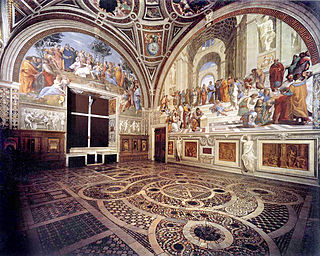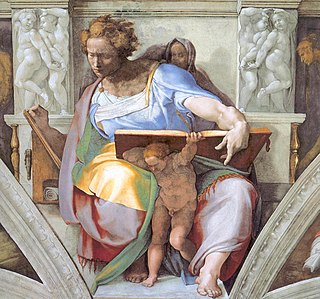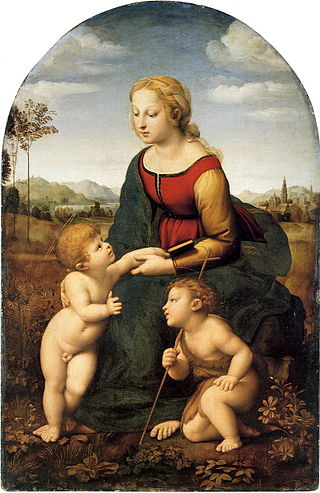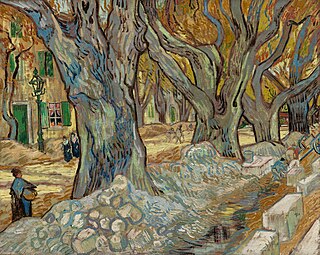
In art, chiaroscuro is the use of strong contrasts between light and dark, usually bold contrasts affecting a whole composition. It is also a technical term used by artists and art historians for the use of contrasts of light to achieve a sense of volume in modelling three-dimensional objects and figures. Similar effects in cinema, and black and white and low-key photography, are also called chiaroscuro.

Sfumato is a painting technique for softening the transition between colours, mimicking an area beyond what the human eye is focusing on, or the out-of-focus plane. It is one of the canonical painting modes of the Renaissance. Leonardo da Vinci was the most prominent practitioner of sfumato, based on his research in optics and human vision, and his experimentation with the camera obscura. He introduced it and implemented it in many of his works, including the Virgin of the Rocks and in his famous painting of the Mona Lisa. He described sfumato as "without lines or borders, in the manner of smoke".

Pollock is a 2000 American independent biographical drama film centered on the life of American painter Jackson Pollock, his struggles with alcoholism, as well as his troubled marriage to his wife Lee Krasner. The film stars Ed Harris, Marcia Gay Harden, Jennifer Connelly, Robert Knott, Bud Cort, Molly Regan, and Sada Thompson, and was directed by Harris.

In art history, the High Renaissance was a short period of the most exceptional artistic production in the Italian states, particularly Rome, capital of the Papal States, and in Florence, during the Italian Renaissance. Most art historians state that the High Renaissance started between 1490 and 1500, and ended in 1520 with the death of Raphael, although some say the High Renaissance ended about 1525, or in 1527 with the Sack of Rome by the mutinous army of Charles V, Holy Roman Emperor, or about 1530. The best-known exponents of painting, sculpture and architecture of the High Renaissance include Leonardo da Vinci, Michelangelo, Raphael, and Bramante. In the 21st century, the use of the term has been frequently criticized by some academic art historians for oversimplifying artistic developments, ignoring historical context, and focusing only on a few iconic works.

The four Raphael Rooms form a suite of reception rooms in the Apostolic Palace, now part of the Vatican Museums, in Vatican City. They are famous for their frescoes, painted by Raphael and his workshop. Together with Michelangelo's Sistine Chapel ceiling frescoes, they are the grand fresco sequences that mark the High Renaissance in Rome.

Iaia of Cyzicus, sometimes (incorrectly) called Lala or Lalla, or rendered as Laia or Maia, was a Greek painter born in Cyzicus, Roman Empire, and relatively exceptional for being a woman artist and painting women's portraits. She was alive during the time of Marcus Terentius Varro. In De Mulieribus Claris, his book of women's biographies, Boccaccio refers to her as "Marcia", possibly confusing her with the Vestal Virgin of that name. According to Pliny the Elder: "No one had a quicker hand than she in painting".

Marcia Tucker was an American art historian, art critic and curator. In 1977 she founded the New Museum of Contemporary Art, a museum dedicated to innovative art and artistic practice in New York City, which she ran as the director until 1999.

The Maiden Heist is a 2009 American crime comedy film directed by Peter Hewitt and starring Morgan Freeman, Christopher Walken, William H. Macy and Marcia Gay Harden. The film was released as The Heist in the United Kingdom.

According to the theory of the art historian Marcia B. Hall, which has gained considerable acceptance, cangiante is one of the canonical painting modes of the Renaissance; i.e. one of the four modes of painting colours available to Italian High Renaissance painters, along with sfumato, chiaroscuro and unione. The word itself is the present participle of the Italian verb cangiare.
Marcia Kure is a Nigerian visual artist known primarily for her mixed media paintings and drawings which engage with postcolonial existentialist conditions and identities.

Portrait of Tommaso Inghirami is an oil painting by Italian artist Raphael. Painted ca. 1509, it exists in two copies, one of which is in display in the Palatina Gallery of Palazzo Pitti in Florence and the other in the Isabella Stewart Gardner Museum in Boston. Known for its realism and attention to detail, the image is reminiscent of works by Hans Holbein the Elder, by whom Raphael may have been influenced in its execution. Stylistically, it relates to Raphael's Portrait of Agnolo Doni, ca.1506, in what Claudio Strinati described in 1998 as its "merciless clarity."
"Jerry's Painting" is the eleventh episode of the American comedy television series Parks and Recreation's third season, and the 41st overall episode of the series. It originally aired on NBC in the United States on April 28, 2011. In the episode, Jerry creates a painting of a topless Greek goddess that resembles Leslie, and Leslie tries to protect it from a conservative activist who wants it banned. Meanwhile, Ben moves in with Andy and April, then tries to teach them how to live like adults.

According to the theory of the art historian Marcia B. Hall, which has gained considerable acceptance, unione is one of the canonical painting modes of the Renaissance; that is, one of four modes of painting colours available to Italian High Renaissance painters, along with sfumato, chiaroscuro and cangiante. Unione was developed by Raphael, who exemplified it in the Stanza della Segnatura.

Paysage Bords de Seine is an 1879 oil painting by Pierre-Auguste Renoir. It was stolen in 1951 from the Baltimore Museum of Art and resurfaced in 2012.

Marcia Jean Hafif was an American painter born in Pomona, California.
American Collectors (Fred and Marcia Weisman) is a 1968 painting by British artist David Hockney. The painting is currently in the collection of the Art Institute of Chicago. It was accessioned by the museum in 1984 after being donated by Frederic G. Pick and his wife, Frances Weis Pick. The painting depicts Frederick and Marcia Weisman, two American art collectors from Los Angeles.

The Large Plane Trees, also called Road Menders at Saint-Rémy is an oil painting by Vincent van Gogh. Painted in 1889 in Saint-Rémy, France, the painting depicts roadwork underneath autumn trees with yellow leaves. In actuality, "The Large Plane Trees" and the "Road Menders of Saint-Rémy" are two different paintings and are sometimes confused as one. Van Gogh painted "The Large Plane Trees" first on a red and white checkered table cloth. He later returned and painted it again on an art canvas.

Marcia Oakes Woodbury was an American painter.
Marcia Hall, who usually publishes as Marcia B. Hall, is an American art historian, who is the Laura H. Carnell Professor of Renaissance Art at the Tyler School of Art and Architecture of Temple University in Philadelphia. Hall's scholarship has concentrated on Italian Renaissance painting, mostly of the sixteenth century, and especially Raphael and Michelangelo.














